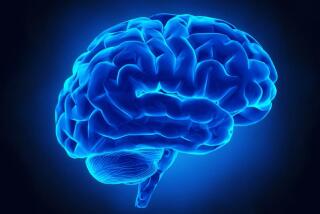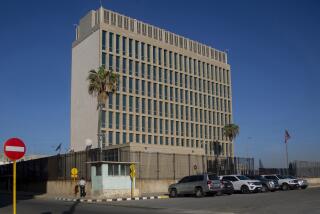Brains of vegetative patients show life
- Share via
In a study certain to rekindle debate over life-sustaining care for those with grievous brain injuries, researchers report that five patients thought to be in a persistent vegetative state showed brain activity indicating awareness, intent and, in at least one case, a wish to communicate.
Of 54 unresponsive patients whose brains were scanned at medical centers in England and Belgium, those five appeared able, when prompted by researchers, to imagine themselves playing tennis, and four of them demonstrated the ability to imagine themselves walking through the rooms of their homes.
One of those patients -- a 22-year-old man who had been unresponsive for five years after an automobile crash -- went on to respond to a series of simple questions with brain activity that clearly indicated yes or no answers, researchers said.
Their work is the first to give physicians and families the prospect of a biological test to determine whether a patient who shows no response to his or her surroundings is conscious and aware of them.
That information, in turn, could bring comfort to families and better care to patients who are able to demonstrate their awareness and communicate their needs. For those consistently unable to respond, such tests may bring a measure of comfort to families inclined to end life support.
The research was published online Wednesday in the New England Journal of Medicine.
But some neurologists cautioned that such a new diagnostic technique might further confound families.
In an accompanying editorial, Harvard University neurologist Allan H. Ropper wrote: “It will now be difficult for physicians to tell families confidently that their unresponsive loved ones are not ‘in there somewhere.’ ” Even when a patient has shown purposeful brain response, “we cannot be certain whether we are interacting with a sentient, much less competent, person.”
Regardless, the study demonstrates that a form of brain scanning called functional magnetic resonance imaging might be used to discern the extent of a patient’s consciousness. It is the latest in a growing body of research suggesting that the medical profession’s methods of classifying unresponsive patients are crude, imprecise and often fail to predict the possibility of recovery.
That imprecision became a touchstone for impassioned political debate in the months leading up to the 2005 death of Terri Schiavo, a 41-year-old heart attack victim who languished, unresponsive, for 15 years before a Florida judge allowed the removal of the feeding tubes that had kept her alive.
Unlike Schiavo, whose brain was deprived of oxygen for five crucial minutes, all of the subjects whose brains showed signs of awareness and intent in the study had suffered traumatic brain injury -- most commonly sustained in falls, motor vehicle accidents, collisions and assaults. Of the 49 patients who failed to respond, 29 had sustained brain trauma and the rest had been subject to illness or injury that deprived them of oxygen.
An estimated 9,000 to 37,000 people in the United States are in a persistently vegetative or minimally conscious state; the number ranges widely because diagnostic definitions are vague.
Dr. Jamshid Ghajar, president of the Brain Trauma Foundation and a neurosurgeon at Weill Cornell Medical College, called the study “very innovative.” Ghajar -- who was not involved in the research -- said it was “remarkable” that a patient considered vegetative for five years could follow complex instructions.
The study’s lead author, Martin M. Monti, said in an interview that he and his colleagues were “absolutely stunned” when, watching the shadowy images of Subject No. 23’s ostensibly vegetative brain, they detected clear responses to yes or no questions.
A staff neuroscientist with the British government’s Medical Research Council, Monti said the possibility of unlocking the wishes of previously mute patients “certainly contributes to the debate” over a patient’s right -- and ability -- to express his or her desire to die. But that was not among the questions asked of Subject No. 23, he said.
Several times when Subject 23 was asked to imagine playing tennis, Monti said, the region of the brain most closely associated with complex motor planning became highly active, and stayed active for 30 seconds after researchers prompted such imagery by saying “tennis.”
Similarly, when researchers asked the patient to imagine walking through the house where he grew up and then said the word “navigate,” Subject No. 23 responded with bursts of activity in the region of the brain involved in constructing and navigating a mental map.
The young, French-speaking man was the only subject who was then trained to answer simple yes or no questions -- whether his father’s name was Paul (yes) or Alexander (no), whether he had siblings and how many -- using the imagery technique he had already learned.
Checking the patient’s responses for accuracy and comparing them to the yes-no brain responses of a group of healthy volunteers, researchers discerned that Subject No. 23 was not only still “in there,” but capable of purposeful thought and communication.
Ghajar cautioned that the failure of some patients to show responses could have a wide range of meanings: that they were temporarily asleep or unconscious; that they could hear and understand, but not sustain their focus long enough to answer; or that they had no conscious awareness at all.
Bioethicist Arthur Caplan said the study would complicate decisions about sustaining life in the netherworld between alertness and unresponsiveness.
“The more these measures of consciousness get complex and fine-tuned, the harder it is to write a recipe about them” in advanced directives, said Caplan, director of the University of Pennsylvania’s Center for Bioethics.







